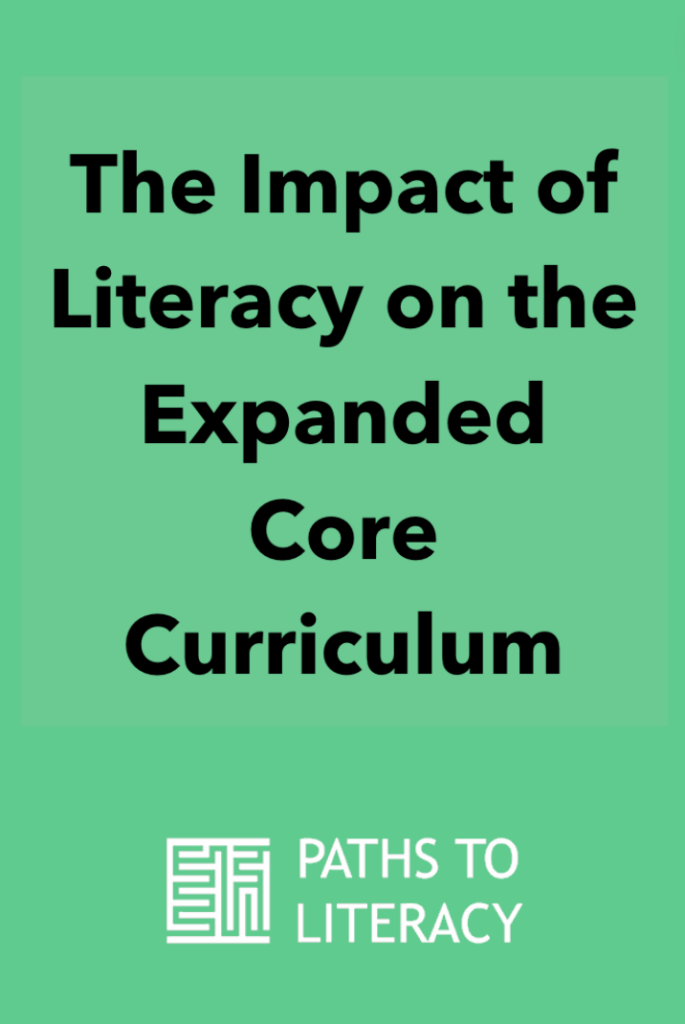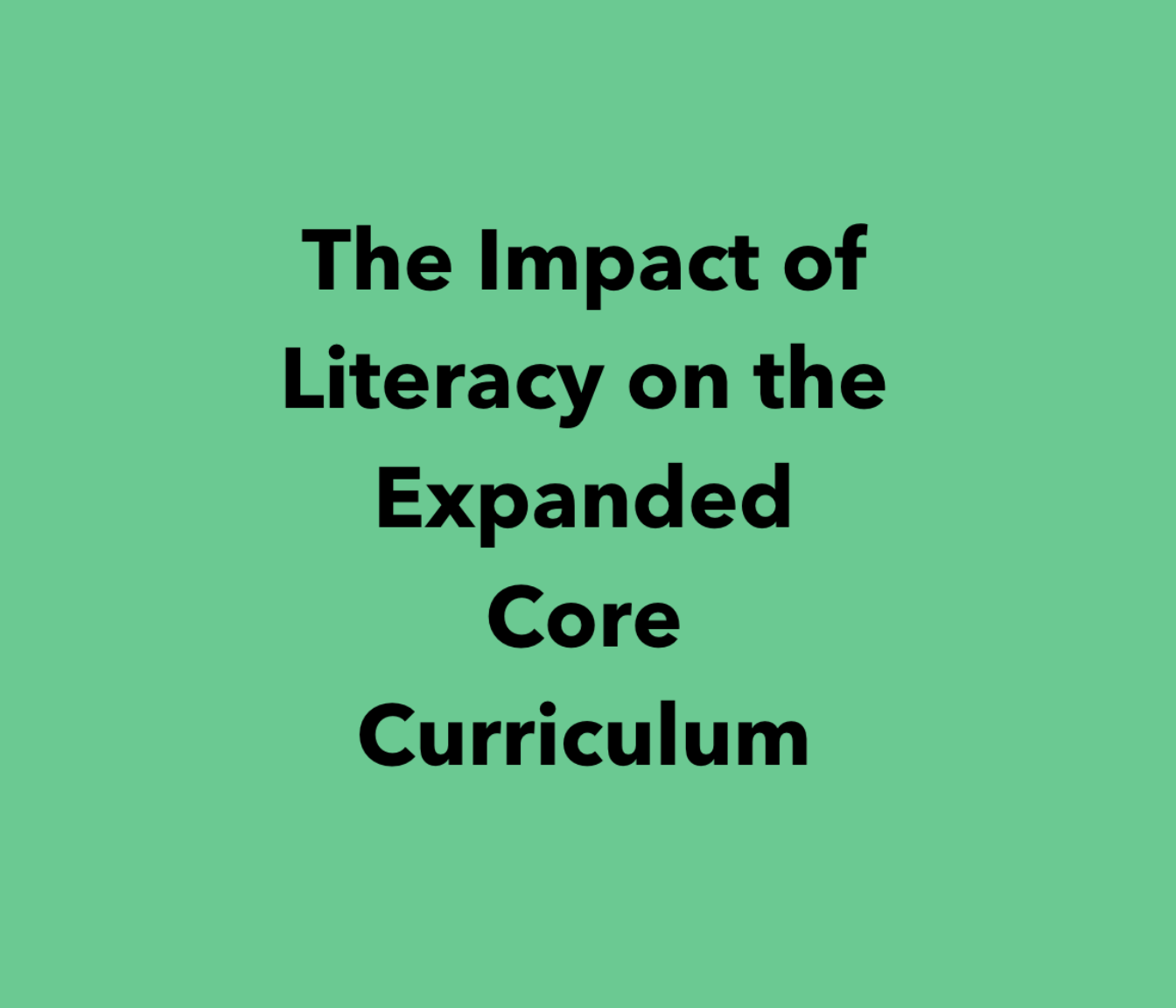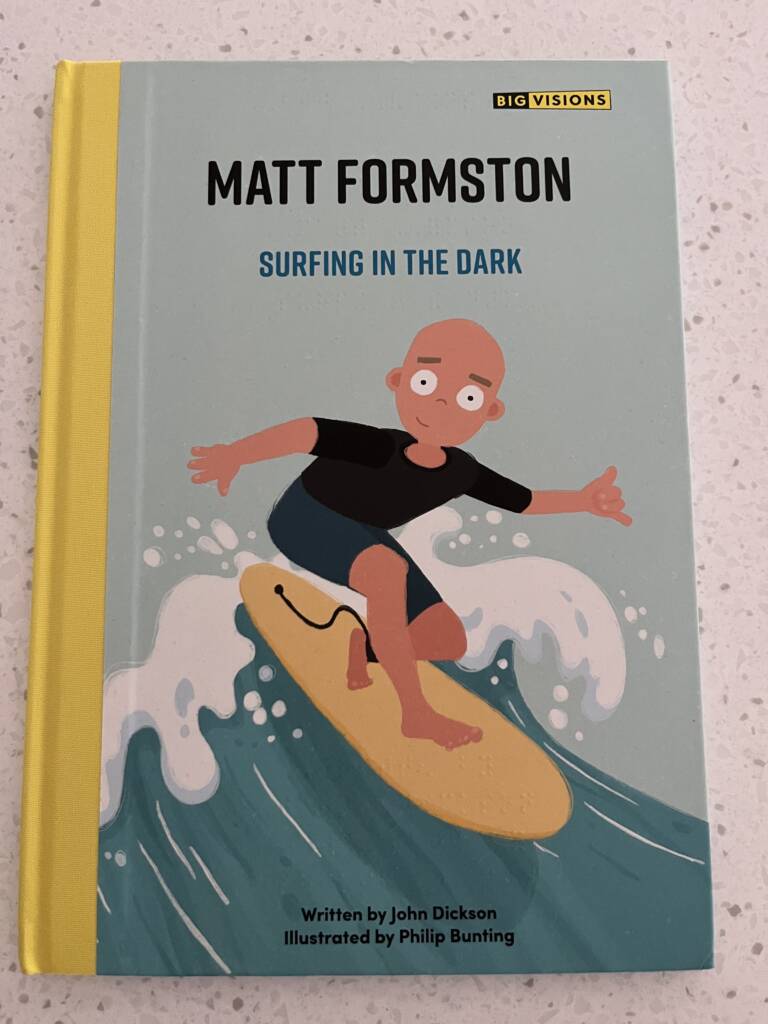By Dr. Phil Hatlen, Superintendent, Texas School for the Blind and Visually Impaired, Austin, TX
Editor’s note: In this article, Dr. Hatlen makes reference to “media literacy.” If you are unfamiliar with this idea, start by reading his article Literacy According to Phil for an introduction to the subject and additional thoughts on literacy.
The actual formal birth of the Expanded Core Curriculum (ECC) happened with the development of the National Agenda in 1993, as the ECC became Goal 8. While few parents and professionals disagreed with the concept of unique educational needs for blind and visually impaired students, real commitment to the ECC has taken years. I once stated that the three stages needed for the ECC were acknowledgment of the need, commitment to the principle, and implementation. Acknowledgment occurred almost immediately. Commitment to the principle took longer, and actual implementation is only now gaining momentum. Some states, provinces, and regions immediately began working toward implementation, but the most difficult problem has been changing service delivery systems so that teachers have time to teach the ECC.
In the early years, as I preached ECC, I know I left the impression that all blind and visually impaired students needed all areas of the ECC. I sounded like those fine, but misguided colleagues of ours who promoted full inclusion with the phrase “All means all.” My tendency to not make exceptions was noticed by some of my colleagues, notably by Susan Spungin, who wisely helped me understand the error of my ways. Now my message to all teachers is to assess every area of the ECC. You might well discover that there are students who are sufficiently competent in one or more areas that you don’t need to address them, at least not at the moment.
1. Compensatory Skills
The first area of the ECC has to do with compensatory skills, including communication modes. This has always been known as a unique need for blind and visually impaired students, and has been an area of instructional responsibility for teachers of the visually impaired (TVI). Literacy and its prerequisites are deeply imbedded in this ECC area of unique need. Mastery of these skills will ensure access to the regular education core curriculum. With the addition of media literacy to our definition, we have the opportunity to provide every blind and visually impaired child with literacy skills appropriate to their needs and abilities.
2. Orientation and Mobility
Doesn’t everything about orientation and mobility have to do with media literacy? If the use of touch is media literacy, then the grip, the tactile response of the cane to an object, location of a surface warning strip with the feet, identification of a landmark while trailing, and the reading of tactile maps are all literacy skills that enhance independent travel. If using air pressure and echoes, listening to traffic flow, using auditory cues, both natural and human-made are all listening skills, and listening is a part of our definition of media literacy, then these skills are literacy skills. If use of low vision greatly enhances the mobility skills of a student, then this, too, is a part of literacy.
I must add that I have had a problem with the professional skills of orientation and mobility specialists because, from the outset of the profession, I have believed that they should know Braille and know how to teach it. The last time I explored this, I didn’t find any O&M preparation programs that required Braille.
3. Independent Living Skills
As we explore the areas of the ECC and relate them to our expanded definition of literacy, it becomes apparent that all of the ECC is dependent on a level of literacy in order to become an integral part of one’s life. I used to define “Independent Living Skills” as everything in the daily routine of a blind or visually impaired student, from personal hygiene to financial management. Tooth-brushing is an independent living skill, and it involves recognition of toothbrush and toothpaste, a literacy activity. Bathing requires knowing hot from cold, location, identification, and cleansing of body parts. Sounds like media literacy to me. In fact, any intended, purposeful action that results in a positive outcome will require some form of media literacy.
I’m not certain where the teaching of independent living skills stands in local school programs, but it has become a major instructional program in many, if not all, schools for the blind. At TSBVI, over 1/3 of our enrollment consists of students over 18 years of age. In discussing reasons for referral from local districts, the two major concerns of local educators and parents are in the areas of independent living skills and career education. This implies to me that the local school districts are having a difficult time delivering these areas of the ECC. More on this later.
This talk is becoming a bit redundant, largely because my expanded definition of literacy leaves almost all learning in the areas of the ECC dependent on media literacy. So I’ll say just a few words about the remaining curricular areas.
4. Social Interaction Skills
Media literacy permeates this area of the ECC, especially auditory information. The student must learn to be a careful listener, for tone, volume, and emphasis will change the meaning of spoken words.
5. Recreation and Leisure Skills
What first comes to mind are the many table games that require literacy in order to play. Goal ball, beep baseball, even bowling require auditory skills in order to participate.
6. Career Education
Interacting with fellow employees and employers is essential to success in employment. Thus, the basic level of literacy needed for employment is the auditory and expressive ability to communicate, a skill that I maintain falls under the definition of media literacy.
7. Technology
Of course, I’m aware of the fact that those who have developed and are promoting the concept of media literacy had in mind the marvelous contributions of technology to our access for information. But I would maintain that the child with severe disabilities who learns to use switches, or the child who learns from Intellitools, is also participating in media literacy.
8. Visual Efficiency Skills
Does it seem to you that those of us who strongly believe in helping children achieve the maximum utilization of low vision are having, once more, to strongly support our position? I can remember when the monumental work of Natalie Barraga so dramatically changed our profession. It was not an easy sell in those days, and now we seem to be having to defend utilization of low vision again. Do I need to explain the link between Visual Efficiency Skills and Literacy? I think not.
9. Self-Determination
“What’s this?” you say. You thought there were eight curricular areas in the ECC, and now Hatlen presents a number nine! Some very wise people, especially Karen Blankenship, suggested that self-determination belongs in the ECC. It was not difficult to convince me! Remember, the litmus test for inclusion in the ECC is if it is a skill or knowledge that is learned differently by sighted and by visually impaired students. Do you believe that many of the skills and knowledge that result in self-determination are learned casually and incidentally by sighted children? Do you believe that blind and visually impaired children will need to learn self-determination in a systematic and sequential manner? Do you observe self-determination as being a problem with some, or many, blind and visually impaired students?
Self-Determination and Learned Helplessness
Many years ago, I read a book by Martin Seligman entitled Helplessness (W.H. Freeman and Company, 1975). It came out at about the same time as Robert Scott’s book, The Making of Blind Men. These two publications had a profound effect on me. Scott described his research (some called it his perceptions) of the manner in which agencies for the adult blind fostered a dependency on them among their clients. Thus, the number of clients always grew, since no client ever “graduated”.
Seligman’s book is about learned helplessness. And reading his book became my first initiation to the term. It has been used widely to describe many conditions since the book was published, but I think Seligman had it right. As I read this publication, I realized that the author never mentioned blindness, but the book was all about blindness. This is what it made me realize. We now have systems in place that deliver services to blind and visually impaired persons, birth to death. It is likely that the blind infant will follow a relatively seamless process from infancy, to preschool, to school, to rehabilitation, to aging, in which there are professional services available at every step. While this is to be desired when used appropriately, it can result in severe learned helplessness. Seligman points out that when decision-making and choices are taken away from persons, it can result in severe reactions, even destruction of the will to live. He cites many examples when intervention was needed that literally gave back to persons their own lives.
Do you agree that we run the risk every day of creating an environment of learned helplessness? I can think of so many examples!! It isn’t just taking away opportunities for making choices or making decisions. What we as professionals need to consider is if we need to create opportunities for blind and visually impaired children and youth to make choices, to make decisions.
One of the most unforgettable stories I have ever heard was from a TVI in rural Northern California. One day a blind third grader ate her lunch in the resource room. She finished half her sandwich, then announced that she would leave the other half on her desk, unwrapped, to eat for lunch the next day. The teacher could hardly contain herself, wanting to explain what the sandwich would be like the next day. But she said nothing, and the child came back the next day to a hard, inedible sandwich. This is allowing the child to make a choice, and to live with the consequences of the choice.
A rehabilitation counselor told me, many years ago, that when most visually impaired young people came into his office, the resulting conversation went something like this:
Rehab counselor: What can I do for you?
Client: Find me a job.
Rehab counselor: Oh, what would you like to do?
Client: I don’t know. Just find me a job.
Rehab counselor: What are you good at?
Client: I don’t know. Just find me a job.
I can imagine the client thinking to himself, “What’s with this guy? He wants me to make a decision, or thinks I’ve already made a decision. The system has done all my thinking for me until now. Why doesn’t this guy be a part of the system?”
This same rehab counselor told me that he longed for the day when a young man, right out of high school, came into his office and said: “I understand you will help me with my future plans. You need to know that I already know my strengths and weaknesses, and what I would like to do. As long as you guide and support me, we’ll be okay. But you will not take over my life!”
Isn’t this what all of us want for our students and clients? We want them to have the knowledge, skills, and literacy ability to own their own lives. And this is why I support adding self-determination to the ECC.
The ECC is a central part of a child’s education.
Before I close, I must remind you that the Expanded Core Curriculum is not an option, and it is not a second-level curriculum. Every child, every student, must be assessed in every area of the ECC, and must receive instruction in those areas that are needed.
I recently had a conversation with some people who suggest that the TVI is not necessarily responsible for the teaching of the expanded core curriculum, but is responsible for seeing that all areas are taught. The real challenge is to assemble others who have the time and can do the teaching. I have heard this many times, and most of the time the conversation then identifies people such as parents, rehab teachers, recreation teachers, classroom teachers, adaptive technology teachers, volunteers in the community, etc. This brings up a concern about whether or not the teacher(s) of the expanded core curriculum subjects must be skilled as teachers of blind and visually impaired students. I think so.
The specific knowledge and skills of TVIs are more needed for the developmental and adaptive requirements of the expanded core curriculum than they are for the regular core curriculum.
- Should we suggest that the parents must be the teachers of independent living skills and social skills?
- Should we suggest that the vocational teacher be the teacher of career education?
- Should we suggest that the P.E. teacher or recreation teacher be the teacher of leisure and recreation skills?
- Should we suggest that the P.E. teacher be the orientation and mobility specialist?
- Should we suggest that the general technology teacher be the teacher of technology?
I think not.
The very reason the Expanded Core Curriculum exists is that the skills and knowledge are so unique, so specialized to blind and visually impaired persons, that the generalist will have no idea how to adapt and adjust teaching to this population.
No, we need our best and most highly trained TVIs to teach the Expanded Core Curriculum!!
Is it safe to say that less than half the blind and visually impaired students in the U.S. are receiving instruction in the Expanded Core Curriculum? Is it correct to say that this does not reflect the philosophy of the teachers, but rather the structure of the job? Let me share with you my concept of the future of instruction in the Expanded Core Curriculum.
University preparation programs must give more emphasis to the Expanded Core Curriculum. This will help ensure that new teachers will have some basic skills in every area of the curriculum. If you agree with me that, for example, social skills are as important as reading skills, then should not the university preparation curriculum reflect this?
Before there was an Expanded Core curriculum, itinerant teachers were running as hard as they could. Then two things happened. With further emphasis on inclusion, itinerant teachers found themselves stretched even more, as their caseloads and geographic areas increased. Second, teachers were told that they were expected to teach the subjects included in the Expanded Core Curriculum. Not only were they expected to teach them, they were expected to assess all areas of the Expanded Core Curriculum and write IEP goals to meet them.
We must share the responsibility. If I assume that teachers of the visually impaired are working as hard as they can, and that emphasis on the expanded core curriculum is impossible to add, then I’m left with only one option; someone else has to do at least part of the work.
I suggest that perhaps it’s time that we, you and I, begin to think about the education of a blind or visually impaired student as a shared responsibility between the local district and the state or regional school for the blind. Suppose that instead of either/or, it became both. Suppose we all sat down together, parents, local district personnel and representatives from the school for the blind, and planned the educational life of a child together. Suppose this led us to the conclusion that much of the Expanded Core Curriculum should be taught at the school for the blind, and that the child should have the privilege of moving back and forth between programs, depending on current needs.
A major flaw in our philosophy and approach to education for blind and visually impaired students is that there is one system that has primary responsibility for the education of each child. I am suggesting that we abandon this position, and explore how we might better meet all the needs of every individual child by having two systems share primary responsibility for the child. Consider the load taken off teachers of visually impaired in local districts. Think of the advantages to many, many children in making available to them the expertise of the staff at schools for the blind. Likewise, think of the advantages that local school education offers to students who might otherwise be destined to spend all of their school years at a school for the blind. So you see, such a partnership will need to work both ways. Every child should be able to access the benefits of both her local school and her regional school for the blind. Of course, there will be students for whom continuous attendance at a school for the blind will be most appropriate, and there will be students who spend their entire educational lives attending their local school.
My fervent hope for the future is that all decisions regarding delivery of educational services to blind and visually impaired students will consist of informed decisions made mutually by parents, local districts, and schools for the blind. Can you imagine a meeting of these representatives of a child, all informed advocates, where short- and long-term decisions will be made regarding placement? As soon as appropriate, the student himself will join this team, and together this group will plan his future education.
I envision a day when teachers and administrators from local school districts, together with parents, will sit at the table with representatives of schools for the blind. I envision a time when such a meeting will not generate any defensiveness, suspicion, hostility, or territoriality. I envision a time when neither local schools nor residential schools will “own” a child. Instead, the family will “own” the child, and the two educational systems will work together, as equal partners, to provide the very best educational program for every individual child. Should we settle for any less?
I leave you today with three challenges:
- Make certain that every blind and visually impaired child has access to assessment and instruction in the Expanded Core Curriculum.
- Examine your definition of literacy, and consider using adjectives to differentiate various types of literacy.
- Tap your creativity and that of those around you so that we may find ways of presenting braille materials in a usable, reader-friendly multimedia format.
This article was originally published by Texas School for the Blind and Visually Impaired (in the Spring 2004 SEE/HEAR Newsletter) and is reprinted here with permission.





